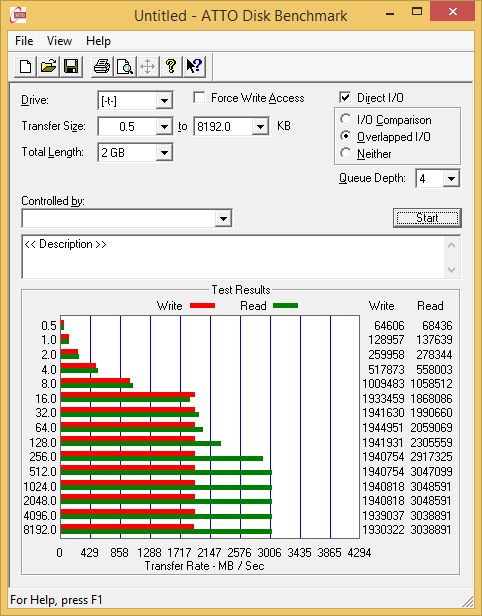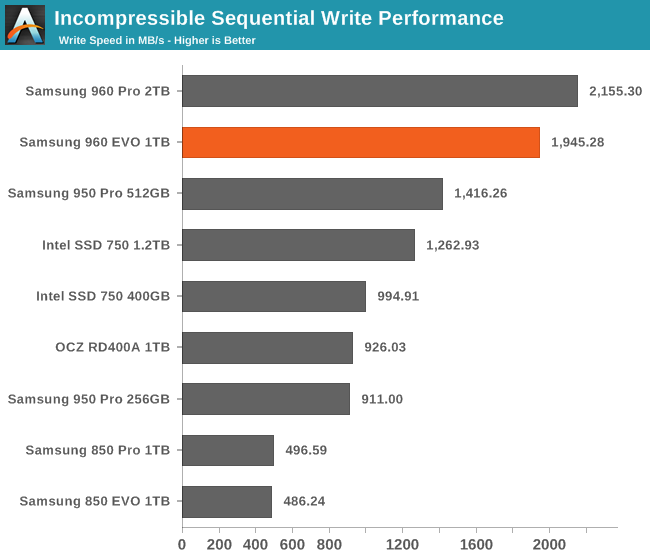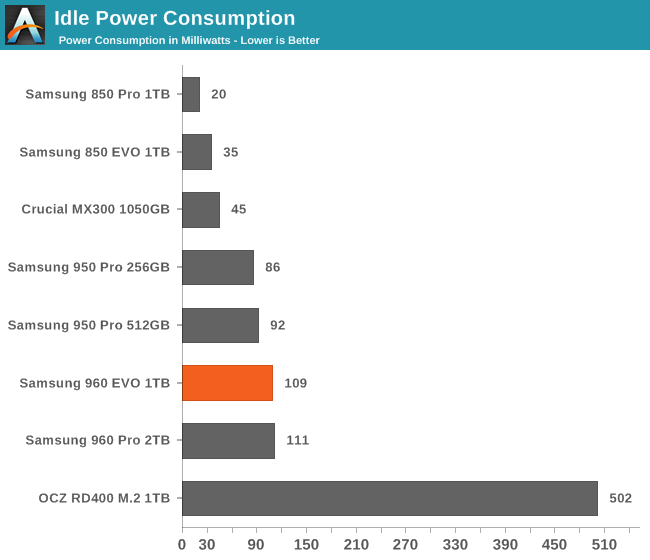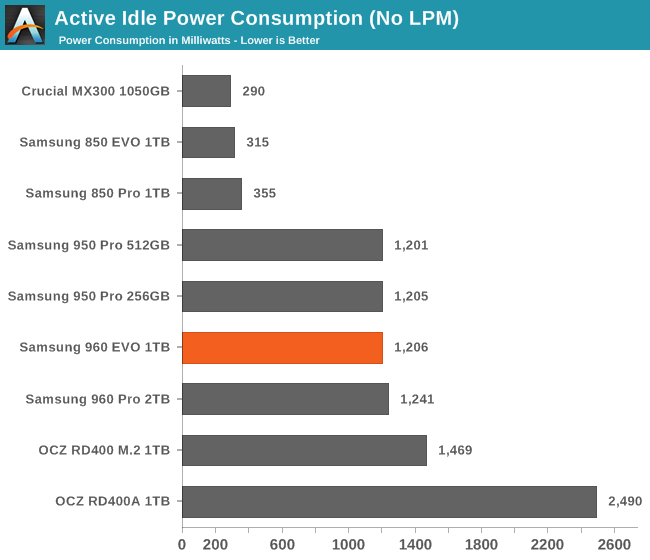The Samsung 960 EVO (1TB) Review
by Billy Tallis on November 15, 2016 10:00 AM ESTATTO
ATTO's Disk Benchmark is a quick and easy freeware tool to measure drive performance across various transfer sizes.
 |
|||||||||
By the end of the test, the 960 EVO and 960 Pro are performing identically. The 960 EVO takes longer to get up to full read speed, and the 960 Pro turns in some slightly better write speeds before thermal throttling levels things out.
AS-SSD
AS-SSD is another quick and free benchmark tool. It uses incompressible data for all of its tests, making it an easy way to keep an eye on which drives are relying on transparent data compression. The short duration of the test makes it a decent indicator of peak drive performance.


Both AS-SSD sequential tests show that the 960 EVO's peak performance really is second only to the 960 Pro, even if in longer tests some other models are able to outperform the 960 EVO.
Idle Power Consumption
Since the ATSB tests based on real-world usage cut idle times short to 25ms, their power consumption scores paint an inaccurate picture of the relative suitability of drives for mobile use. During real-world client use, a solid state drive will spend far more time idle than actively processing commands. Our testbed doesn't support the deepest DevSlp power saving mode that SATA drives can implement, but we can measure the power usage in the intermediate slumber state where both the host and device ends of the SATA link enter a low-power state and the drive is free to engage its internal power savings measures.
We also report the drive's idle power consumption while the SATA link is active and not in any power saving state. Drives are required to be able to wake from the slumber state in under 10 milliseconds, but that still leaves plenty of room for them to add latency to a burst of I/O. Because of this, many desktops default to either not using SATA Aggressive Link Power Management (ALPM) at all or to only enable it partially without making use of the device-initiated power management (DIPM) capability. Additionally, SATA Hot-Swap is incompatible with the use of DIPM, so our SSD testbed usually has DIPM turned off during performance testing.


Idle power for the 960 EVO is the same as for the 960 Pro. Our usual testbed configuration does not engage any explicit power saving modes so the 960 EVO idles at 1.2 W where most SATA drives will draw much less than 1W. On systems that make use of NVMe power saving capabilities, idle power will be only a few times higher than the best SATA drives, and this is without making full use of PCIe link power management.










87 Comments
View All Comments
Foralin - Tuesday, November 15, 2016 - link
I'd like to see this kind of analisys for the new Macbook Pro's SSDphilehidiot - Tuesday, November 15, 2016 - link
I think that often Apple use a couple of different suppliers for their SSDs (certainly was the case when I bought my Air ages ago) and they're unlikely to hand out samples for testing as if there's one thing Apple seems to hate, it's scrutiny. This means that you might have to buy quite a few Macbooks, ID the SSD and then you'd still never know if they were using one, two, three or even four different suppliers unless you got loads of people to run the appropriate software and then went on a shopping spree. Hoping of course that you could return those you've unpacked, set up, tested and carefully repackaged.... Whilst it'd be nice, Apple don't make it easy and unless you're loaded it's not going to be practical.repoman27 - Tuesday, November 15, 2016 - link
Apple sourced SSDs from Samsung, SanDisk and Toshiba back when they used SATA SSDs, but went 100% Samsung when they switched to PCIe. The 2015 MBPs were all SM951, for instance. From what I've seen thus far, the 2016 MBPs use a new, in-house designed PCIe 3.0 x4 NVMe controller paired with SanDisk NAND.repoman27 - Tuesday, November 15, 2016 - link
And I take that back that last bit because I just saw a post with a photo of the internals of the MBP w/ TouchBar and it looked to have a Samsung SSD on board.Threska - Tuesday, November 15, 2016 - link
One disadvantage I see of the M.2 form-factor is inadequate cooling on some motherboards, compared to their more traditional SSD brethren.willis936 - Tuesday, November 15, 2016 - link
There's a quick fix for that: an ugly PCIe adapter with a heatsink. Or actually slapping some RAM heatsinks on the drive itself. I've been looking for a 2x M.2 to PCIe x8 adapter. The only ones I've found are expensive server adapters. Considering one of these drives nearly saturates 4 PCIe 3.0 lanes it seems that a regular consumer who wants to do RAID 0 should run their GPU in x8 (or go all out on HEDT) and get two PCIe adapters with heatsinks.TheinsanegamerN - Tuesday, November 15, 2016 - link
The issue is that is only possible on desktops. Laptops are more SOL in this regard.willis936 - Tuesday, November 15, 2016 - link
More performance = more power. It would be neat if they made different power profiles that could be set by the user through the OS. I don't want 5W pulled from my laptop just for my SSD to read 2 GB/s but I also don't need it to run that quickly.MajGenRelativity - Tuesday, November 15, 2016 - link
That's a nifty idea! I would like that too :)Billy Tallis - Tuesday, November 15, 2016 - link
NVMe already has that feature. Drives can define multiple power states, both operational and non-operational idle. The definition of those power states can include information about the relative performance impact on read and write throughput and latency, and how long it takes to enter and leave the different idle power states. For example, the 960 Pro declares a full-power operational power state with maximum power draw of up to 6.9W, and restricted operational power states with limits of 5.5W and 5.1W. It also declares two non-operational idle power states with limits of 0.05W and 0.008W, which my measurements have haven't accurately captured.Making full use of this capability requires better support on the software side.